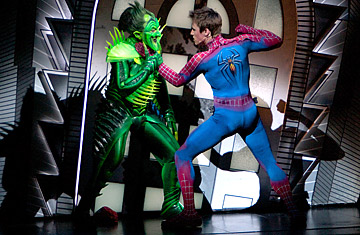
A publicity image of Spider-man: Turn Off the Dark shows villain Patrick Page, left, and Reeve Carney in the title role.
At least four performers were injured doing the technically demanding stunts. Opening night had to be delayed repeatedly as the show was being worked on. The critics slammed the show even before it was finished. Finally, most ignominiously, director Julie Taymor was ousted in March, as a new creative team was brought in to make major revisions in the Broadway musical that had become a late-night TV punch line.
When Spider-Man: Turn off the Dark finally opened officially on Tuesday night, after the longest and most troubled preview period in Broadway history, the show itself seemed almost an anticlimax. The red-carpet crush was so chaotic (among the celebs in attendance: Steve Martin, Matt Damon, Barbara Walters and former President Bill Clinton) that the curtain had to be delayed — naturally — by 45 minutes. During the long wait, a woman walking up the aisle next to me tripped on a step, and had to be carted off with her wrist in a splint. At least this is one show where you don't have to wait long for the medics to show up.
And when the actors finally took their bows, nearly three hours later, the drama still wasn't over. During the curtain calls, Bono and The Edge, the U2 members who helped launch the show, wrote the score and then got caught in a quagmire they never foresaw, acknowledged the standing ovation and thanked everyone for their patience. Then Bono introduced "the person without whom none of this would be possible" — Julie Taymor, who is still credited as the show's "original director" and who graciously took her bows alongside the people who got her canned.
Oh, and for the musical in between all the theatrics? It's not that bad.
In truth, Spider-Man was never quite the disaster that the early reviews a little too gleefully suggested. When I saw it at an early December preview performance, the chief problem — hardly a negligible one — was the murky and overly ambitious script by Taymor and Glen Berger, who felt the need to embellish a generic superhero saga with all sorts of narrative layering and mythological mumbo-jumbo. The story was confusing and misshapen; it didn't build but seemed merely to run down.
In a certain limited sense, the salvage job (overseen by Philip William McKinley) has been successful. Nearly all of Taymor's narrative experiments (including most of the scenes involving Arachne, the original spider of Greek mythology) have been junked. The climactic, high-flying fight between Spider-Man (Reeve Carney) and the Green Goblin (Patrick Page), which originally ended the first act (the Goblin reappeared in Act II in a dream, or something), has now been moved, more conventionally, to the end of the show. Essentially, that means most of what was previously jammed into the first act is now stretched out to fill the entire show. Which means a more logical narrative, more love scenes between Peter Parker, Spidey's alter-ego, and his girlfriend Mary Jane (Jennifer Damiano), and more dull stretches.
Not all the cuts were good ideas. Gone, for example, are Arachne's eight-legged, high-heeled henchwomen, one of Taymor's more inspired stage creations. (Gone too is their much-derided song, "Deeply Furious," which I liked.) Still around, however, are the "Sinister Six," a band of supervillains dressed up in bad Halloween costumes, who get dispatched so quickly that they seem merely to be time fillers.
But there are compensations for the eye and ear. The set design — a mix of comic-book pop-ups and dark, Tim Burton-ish cityscapes — is as striking as ever. The Bono-Edge score, moreover, is no disappointment. It really rocks, and the repeated five- and six-note figures that anchor the anthemic "Rise Above" and the sweetly melancholy duet "No More" have stayed with me. There's more humor now (when the Goblin tries to leave a phone warning with the newspaper, he can't get past the automated voice prompts), and one bright new number, "A Freak Like Me Needs Company," which provides a lift at the start of Act II.
And, of course, there's the flying. It looks more workmanlike than dazzling the second time around — hardly deserving of the disparaging label that some have stuck on the show: a Vegas spectacle. If only. Spider-Man is better now, but it's still just a cut above an ordinary Broadway spectacle.
